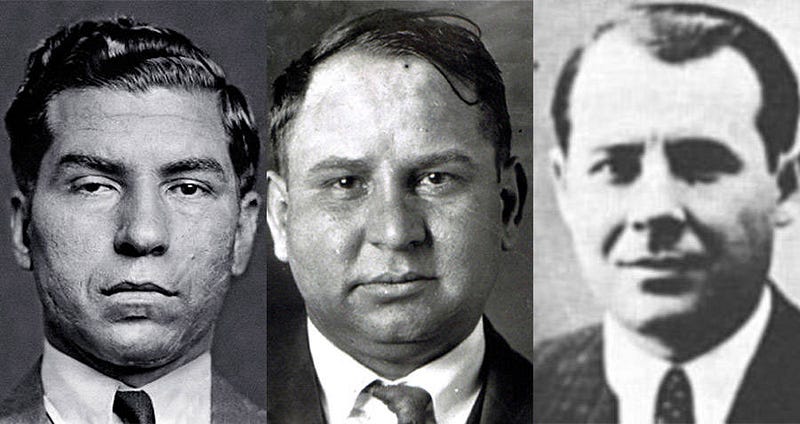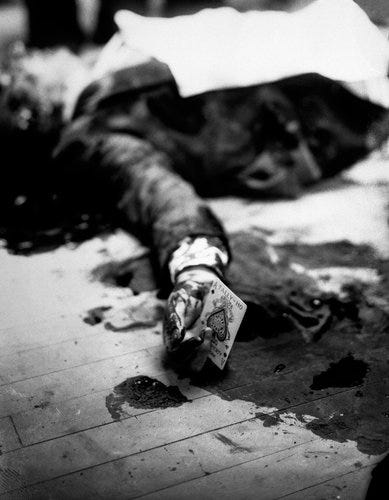The Castellamarese War

April 15, 1931, Coney Island, Queens, New York, Italian Restaurant: Nuova Villa Tammarro. Mob Boss Giuseppe “Joe the Boss” Masseria is shot dead by a group of Assassins. The death was set up because Lucky Luciano and Mob Boss Salvatore Maranzano had made a deal to end the Castellammarese War. September 10, 1931, Helmsley Building, New York City. A team of hitmen assassinate boss Salvatore Maranzano. What led to the Castellammarese War? What happened because of the Castellammarese Wars?
Prohibition Era and Lucky Luciano

Lucky Luciano was recruited into the mob by Joe the Boss leader of the Masseria Family during the late teens. January 17, 1920 the 18th amendment becomes a law and it is officially enforced and this period is known as the beginning of the prohibition era, all drinking alcohol is banned in the United States. In the late teens Luciano is a gunman for Joe the Boss. Prohibition in the United States would go on for the next 13 years. Shortly, after entering New York's criminal underworld Luciano started working for Arnold Rothstein. Rothstein was known as a successful gambler, bookmaker, and the architect of the infamous 1919 black sox scandal. By 1925, Lucky Luciano is a millionaire and Arnold Rothstein is assassinated. Luciano then returned to work for the Masseria family.
Lead into the Castellammarese War
Salvatore Maranzano arrived in the United States in 1925 with orders to take over the Castellammare family.
The war began in 1929 and it was between two “mustache Pete’s”. Mustache Pete’s were old Sicilian mobsters who believed in running the mafia the old school way. This meant that they demanded tribute in the form of money from those that served them, and they could only conduct business with Italians. They wore very long mustaches, and this is how the nickname was born. Salvatore Maranzano and Giuseppe Masseria were two old “Mustache Pete’s”.
The war started because factions from the Maranzano family and factions from the Masseria family wanted to make more money and each demanded tribute from the other family. The factions would clash on the streets of New York City. Prior to Maranzano’s arrival in the U.S. the Masseria family was the biggest and most powerful mob family in organized crime. Once Maranzano arrived he changed the way his family did business and eventually culminating in a war between the two most powerful organized crime families in New York City.
Allies
The allies of the Masseria family consisted of Charles “Lucky” Luciano, Vito Genovese, Gaetano Reina, Frank Costello, Tommy Lucchese, Albert Anastasia, and Joe Adonis. The allies of the Maranzano faction consisted of Don Vito Ferro (Sicilian mob boss), Joseph Bonanno, Stefano Magaddino, Gaspar Milazzo, Salvatore Sabella and Al Capone. The allies was significant until the war hit it’s peak, then the mobsters started to create new alliances and make new deals with the faction that would eventually win the war.
The War
Prior to the beginning of the war the Castellamarese faction was controlled by Nicolo Schiro. Schiro attempted a deal with Masseria by paying him tribute, soon after he disappeared. Members of the Maranzano family began to hijack liquor trucks that were controlled by the Masseria family.
In the late 1920s, Gaetano Reina and Joe Masseria form a faction. Reina was a capo in the Morello crime family, before he, Masseria and Salvatore D’Aquila split off and created their own families. Reina’s family controlled the ice boxes and ruled over the Bronx and parts of Harlem.
February 26, 1930, Joe the Boss Masseria orders a hit on mobster Gaetano Reina. Reina is assassinated as he is leaving an apartment belonging to his mistress. It is revealed that the hitman in this murder is Vito Genovese, a Masseria loyalist.
August 15, 1930, mobsters loyal to Castellammare family assassinated Giuseppe Morello, who was an enforcer for the Masseria Family.
September 9, 1930, the loyal mobsters once again hit the Masseria family. This time they assassinated Joseph Pinzolo in an office near times square which belonged to Thomas Luchesse. Pinzolo was in charge of the ice rackets for the Masseria family. The loyalists the were responsible for these two hits were Reina family, and they soon became members of the Castellammare family.
October 30, 1930 Chicago, IL Masseria strikes back. Giuseppe “Joe” Aiello, a Castellammarese ally is assassinated. The hit was carried out by a Masseria ally hitman, Manfredi “Al” Mineo.
November 5, 1930 Bronx New York, Mineo and his loyal Lieutenant Steve Ferrigno are assassinated in a courtyard. The actual target of the hit was Masseria who was observed in and around the building. Maranzano hitmen rented and apartment in the building prior to the hit. The hitmen observed Mineo a Masseria crime family members and they seized the opportunity.
The Deal to End the War
The Young Turks was a group of mobsters that consisted of Vito Genovese, Frank Costello, Tommy Lucchese, Albert Anastasia and Joe Adonis. The turks were a group of young mobsters who opposed the mustache pete’s and there way of doing business. Lucky Luciano represented the “Young Turks” and they believed that doing business with anyone was okay if money was being made, and the requirements to do business were not as strict as the ways of the old pete’s.
Maranzano struck a deal with Lucky Luciano and Vito Genovese to end the war if they betrayed Masseria and this effectively meant that the Masseria family was at the end of its life. Maranzano then turned to Luciano and a deal was put in place to get rid of Masseria. One reason Luciano agreed to the deal was that the Young turks wanted to start making money again, and the war was hurting their profits. Maranzano made Lucky Luciano believe that he wanted to get rid of the old Sicilian ways of doing business.
April 15, 1931 in a Coney Island restaurant Nuova Villa Tammarro, Masseria is seated at a table playing cards with a few members of his family. Masseria is shot three times once in the head, chest and stomach. The hit team included Albert Anastasia, Vito Genovese, Bugsy Siegel, and Joe Adonis. Once Masseria was assassinated it signified the beginning of the end to the Castellamarese war.

Capo di Tutti Capi
Unbeknownst to Luciano was that Maranzano was ordered by a powerful Sicilian boss, Don Vito Ferro to take control of the mafia in the United States. Maranzano planned on becoming the boss of bosses and having those under him pay tribute to him, and do business with only Italians. After the Maranzano faction declared victory in the Castellammarese war, Salvatore anointed himself “capo di tutti capi (boss of bosses) and the unexpected move took Luciano by surprise. The mobsters that survived the Castellammarese war owed allegiance to Maranzano. Those mobsters that aligned themselves with Maranzano would go on to become the initial architects of “La Cosa Nostra”.
The End of the War
The official end to the Castellamarese War was when Maranzano was finally assassinated. The boss of bosses role that Maranzano took, sealed the deal for the end of his reign. September 30, 1931, Maranzano was assassinated in his office by a team of hitmen. The hitmen were recruited by Jewish mobster Meyer Lansky. The team of hitmen included Samuel “Red” Levine and Bo Weinberg. Lucky Luciano would go on to lead mobsters known as the “Young Turks”. The Young Turks under the leadership of Charles “Lucky” Luciano took over the control of the mafia in the United States and “La Cosa Nostra” was born. Under Luciano further organization took place.
The Outcome
The “Boss of Bosses” title was eliminated and a governing body was put into place. A mafia family would now consists of a boss, underboss, and a consigliere. Below the underboss the family was set up in crews run by a captain, under that person would be a soldiers, and under the soldiers are associates who are yet to be inducted into the mafia. The five New York Families would sit on this commission and two additional families making it a total of seven organizations. The commission was established in 1931 at a meeting in Chicago. The commission was now established and its first board consisted of Charles “Lucky” Luciano (Genovese Family), Vincent Mangano, Tommy Gagliano (Luchesse Family), Joseph Bonanno (Bonanno Family), and Joe Profaci(Profaci/Colombo Family), Al Capone (Chicago Outfit)and Stefano Magaddino (Buffalo Family). The new commission voted Luciano as the Chairman of the board, and an agreement was reached to have a meeting every five year’s or when intervention was needed from the families to resolve a matter.
The Castellammarese war lasted from February of 1930 until April of 1931, it was a cold blooded brutal war for control of illegal rackets in New York City. The end of the “mustache pete’s” were very close to each other. Betrayals is what ultimately caused both old school bosses to be assassinated. The war did produce today’s mafia structure in the United States, and it created the Commission, the governing body of the Mafia.
Comments